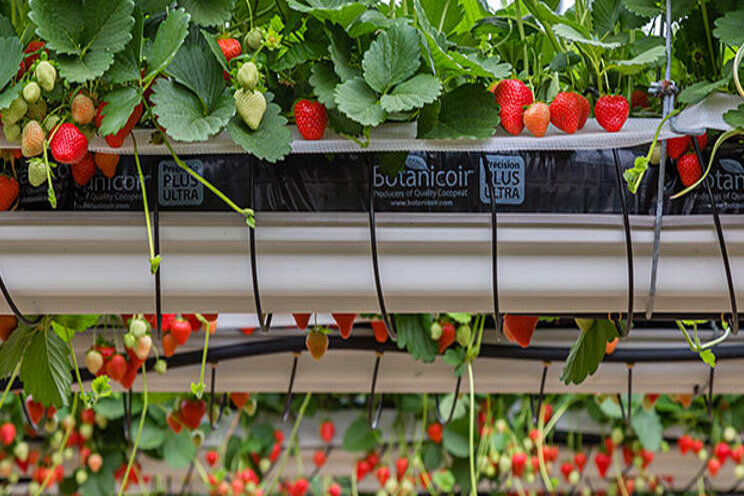Troughs, pots or bags - the debate continues
Added on 22 July 2020

Coir has since become the substrate of choice. Most growers have moved on from the peat bag that was common 15 years ago, thanks to rapid improvements in the quality of coir substrate and the knowledge associated with its use. This has also reduced the risks for growers who wished to move to substrate for the first time.
Plant health, yields and potential reusability have all helped make coir the success it is today. Botanicoir, which celebrates its fifteenth birthday this year, has been at the forefront of the development and improvement of the coir strawberry bag during that time, culminating in the recently launched, new and improved Precision Plus Ultra mix.
Although the industry seems set, and very happy, using 100% coir substrate, the ongoing question remains - should it be used in bags, troughs or pots? This debate has come to the fore again in 2020, as growers sharpen their focus on flexibility, ongoing costs, labour issues, and waste management.
Mark Davies, head of fruit at Botanicoir's partner company, Agrovista, says there are pros and cons to both systems.
"Botanicoir Precision Plus Ultra bags will fit a variety of support systems, including pipe-and-wire as well as gutters. However, trough-based systems are quite specific in their support requirements, so if a grower has an existing table-top area this may dictate whether troughs or pots can be used at all, and if so, which ones.
"It is cheaper to set up a bag system than troughs or pots. However, if you might consider moving on to troughs or pots in the future, make sure that your support system is compatible for both.
"A trough or pot system may be more economical in the longer term, due to lower coir replacement costs. However, troughs and pots need to be washed and sterilised when coir is changed."
Trough and pot systems do offer greater flexibility, Mark adds. Growers can choose plant numbers per linear metre, which is not possible with a strawberry bag with pre-cut planting holes. This means they can vary plant density between seasons and can make last-minute changes should plants arrive larger or smaller than anticipated.
"One metre troughs, very popular in Holland, allow greater flexibility in plant numbers per linear metre - either odd or even numbers. Using 50cm troughs will restrict the grower to planting even numbers per linear metre, as all troughs must have equal plant numbers to avoid inconsistencies in water and fertiliser applications."
A trough can be moved around at any stage of the production process without fear of root disturbance, allowing growers to exploit multi-cropping systems. Pots of course offer the ultimate in flexibility as spacings can be varied according to growing model.
"However, when planting troughs, growers must ensure plants are placed evenly throughout the trough," Mark says. "There are no pre-set planting positions, unlike a strawberry bag with pre-cut holes, so this will call for greater supervision."
Trough and pot systems often have an exposed surface, allowing the use of a pressure-compensated drip pipe to be laid on the coir. Bag systems must be irrigated with a Woodpecker-type drip system. Mark says: "Water use will be slightly increased with an exposed trough/pot surface due to increased evaporation when compared to the more enclosed strawberry bag."
Exposed trough/pot surfaces also mean training of fruit trusses must be good to avoid fruit sitting on the coir surface. In addition, the germination of windblown weed seeds could be more of an issue
"However, good farm hygiene, and the fact that the surface of coir will stay relatively dry, should minimise this risk. Some growers use a thin polythene to cover the tops of the troughs to avoid these issues."
Trough and pot choice is very important. The Bato range has legs to avoid contact with the soil surface, reducing the potential spread of soil borne pests and diseases. The original Bato 1m trough has been developed further, and Agrovista now uses a lot of the new 1m Bato WAVE troughs which are a little lighter but made on a more efficient double-chamber machine.
Mark says: "At Agrovista, we would take all of these factors into consideration when asked for our advice on which system a grower should adopt. We would then make a recommendation on an individual farm basis."The Botanicoir Naked Strawberry Slab offers growers an efficient solution to filling troughs and pots, without the need for specialist trough filling equipment, or handling vast quantities of bulk coir as used to be the case.
Simon Harris of Makins Yorkshire Strawberries says: "We have grown strawberries using Botanicoir slabs in Bato troughs since 2017. In that time the product has performed as expected, encouraging root growth and development, maintaining air and water availability and maintaining a stable structure throughout the rooting environment.
"Additionally the Ultra particles present in Precision Plus Ultra have given us the confidence to replant without concerns about the structure breaking down. We intend to continue using Botanicoir products to help us produce the very best."
For further information on Botanicoir and Bato substrate systems please contact Mark Davies on 07979 703 526 or mark.davies@agrovista.co.uk
Source and Photo Courtesy of Hort News
Source: Hort News
More news















